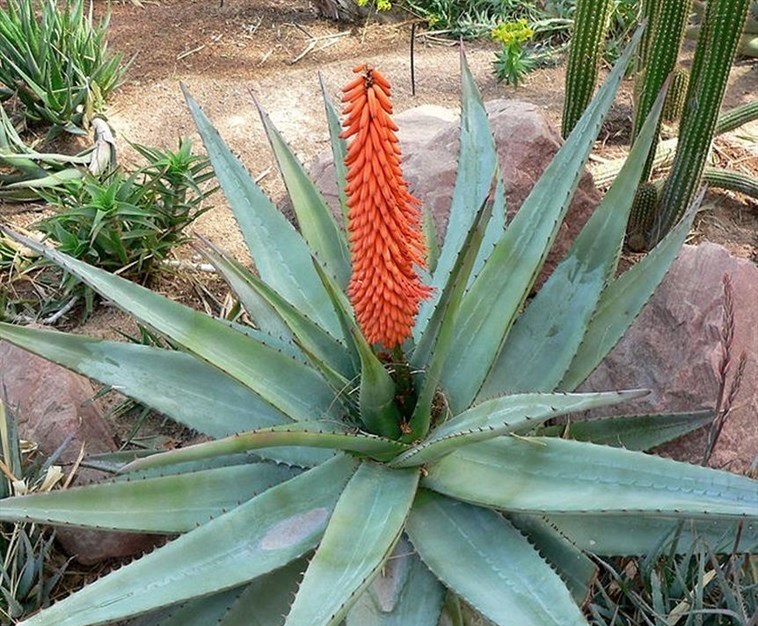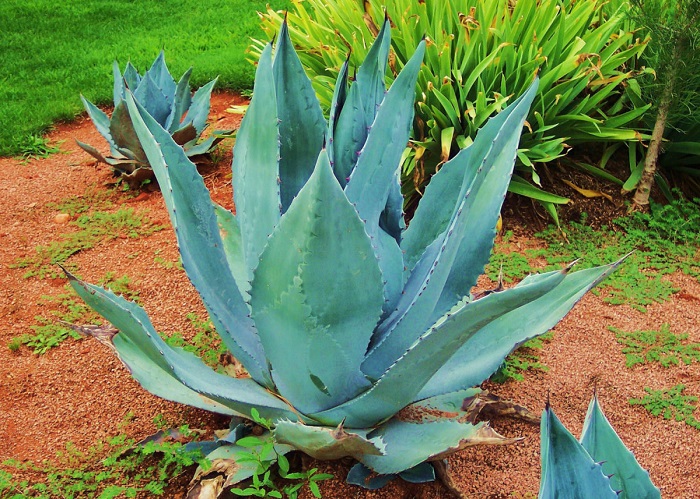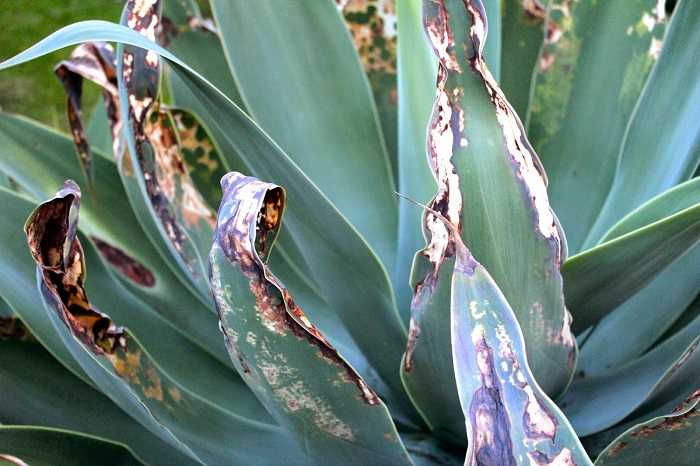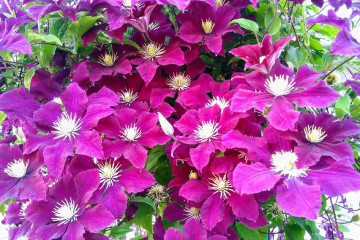Agave, a plant - what it is and how it blooms
Content:
Agave plant is a unique decoration of artificial landscapes. It is distinguished by its huge rosettes of hard long thorny leaves.
About the history of appearance
Agave is the oldest plant in Mexico. They called her that by the name of an ancient Greek mythological character. Agave was the daughter of Cadmus. He was the founder of the city of Thebes. The story says that the girl did not believe in the divine nature of Dionysus, and he made her head insane. Then she killed her own son Pentheus.
Agave is common in the Caribbean, Central and South America. In the second half of the 16th century, it was brought to Europe.
Description
What is agave? Agave is an evergreen plant of the Asparagus family, Agave subfamily. The culture is undemanding to care for. Her native place is Mexico.
Agave is a succulent. More than 250 species are found on the American continent. It is a rosette of hard, thorny, long leaves that retain moisture. Its diameter is 15 centimeters - 5 meters.
The color of the leaves ranges from green, blue to white or lilac. Variegated species are often found, as well as those containing longitudinal contrasting stripes.
There are agaves with spines or fine hairs. Agaves are diverse in appearance. Their specific differences are in size, color, leaf shape.
Agaves bloom once in a lifetime and then die. This happens around the age of 100.
Agaves are mainly found in warm regions, but there are varieties that are more resistant to cold weather.
Where it grows in nature
Under natural conditions, agave grows in the mountains of Mexico with a hot climate, as well as in regions of North and Central America. Mostly found on rocky soil. Agave tolerates dry periods and high temperatures well. On the continent of Eurasia, the plant appeared after the discovery of America.
What is made from agave
Many products and products are made from agave:
- fabrics woven from plant fibers;
- making ropes, twine, ropes;
- wrapping paper;
- tequila is a national drink that can often be found in nightclubs in any city;
- mezcal - an alcoholic drink;
- used in folk medicine because of its beneficial properties, similar to aloe;
- pulque drink;
- rugs;
- using agave fibers to make a dart target;
- make agave juice from fruits;
- leaves, flowers and heartwood can be eaten;
- a Venezuelan drink is made from agave stalks - kokui;
- flower arrows are fried for eating;
- the agave fruit is used to make a syrup similar to honey;
- make medicines, and also produce hormones - cortisone, progesterone, homeopathic medicines, contraceptives are produced in China;
- used in cosmetology.
The benefits of agave are enormous.
Types and varieties for indoor breeding
For growing in room conditions use:
- American agave;
- drawn agave;
- Queen Victoria Agave;
- other varieties.
Blue agave
Blue agave what is it? It is a plant with fleshy leaves that are pointed in the shape of a sword and have thorns. Distinctive features of this type are the blue sheen of the plates, their dullness and density. Sheets reach 2 meters. The plant grows in Mexico. In appearance it is similar to the cultures on the Black Sea or Mediterranean coast.
Tequila is made from blue agave.
Blue agave is a cactus or not
Cactus - agave or not, many people doubt. In fact, this plant is not a cactus. It is considered a related culture of garden lily, indoor amaryllis, sansevieria. Its classification is as follows: it belongs to herbaceous plants, to the Liliaceae family, is a succulent, can accumulate and store moisture in the leaves during dry periods.
American agave
Agave Americana is found most often. Grows in southern gardens and parks. Sometimes it is grown in areas with a temperate climate, transferring it to open ground only for the summer period.
The plant is large and powerful, the rosettes reach 3 meters. Leaves are blue-green with thorns, hard and curved, their length is 1.75 m.
Queen Victoria Agave
The plant is most suitable for indoor growing. The leaf rosette is 60 centimeters long. The length of the plates is 10-15 cm, the width is 5-7 cm. The color of the leaves is dark green. Oblique white lines are located on the top and bottom sides. One long black spine grows at the tips of the leaves. Its length is up to 2 centimeters. There are small thorns along the entire length of the leaf.
Arizona agave
Arizona agave what is it? A plant with a wide rosette, the leaves are light green with spines at the edges, depressed in the center like boats. Only 2 species of Arizona agave survived. They are protected by the Tonto National Forest. The native land of the plant is in the New River and Sierra Ancas mountains.
Features of caring for agave at home
Agave is an unpretentious plant at home, so even a beginner can take care of it.
Temperature
For agave, a room temperature of 18-24 degrees is suitable. In summer, she tolerates heat well. In winter, the plant needs a colder place. To do this, it is taken out, for example, on a balcony with a temperature of 6-8 degrees.
Lighting
Agave room needs a place where the sun's rays will hit it for several hours every day. She is a light-loving plant. In some cases, you can add light using artificial sources.
The plant requires 14-16 hours of lighting per day.
Watering
You need to pour water at the root. If droplets come into contact with the outlet, rot may form. The soil needs to be dried a little more than half in depth. In winter, when you move the plant to a cool place, you need to water less often.
Spraying
For agave, drought is a common occurrence, so it does not need to be sprayed additionally. In the garden, the agave must be protected from heavy rain and dampness.
Humidity
Additional moisture is not required for agave. The indoor air must be dry. The room needs to be ventilated, but without creating a draft.
Priming
In the soil for agave, you need to add 30 percent drainage so that there is no stagnation of moisture. The soil is selected as for a succulent plant. A soil with a pH of 6.8 to 7 is suitable for agave.
Top dressing
Fertilize agave in spring and summer. Selected top dressing as for a cactus or succulent. Fertilizers are applied every month of the spring-summer period.
If agave is properly looked after indoors, it will delight the owner for a long time with its attractive appearance.
In winter
For wintering, the plant must be moved to a cold room. For agave, coolness is more favorable. This helps to maintain its attractive appearance. At room temperature, agave's appearance deteriorates: it stretches, the leaves become thinner, and the plant gradually weakens.
At a temperature of 5-10 degrees, all processes in plant cells slow down. Agave is dormant. So she tolerates winter well.
How agave blooms
How does agave bloom? The plant throws flower stalks to a very high height, up to about 10 meters. They have up to 10,000 buds. They are shaped like dragons bent over a rosette.
If the plant releases a peduncle from the center of the outlet, then after that it dies. Sometimes the agave releases flowers from the side, then it continues to grow. Some species bloom at 30, others only at 100.
Types and shape of flowers
Agave flowers are yellow, cream, pink, white, orange, greenish. They resemble bells or daisies in shape, and can also gather in panicles or fluffy inflorescences. The type of flower is different for each agave variety.
Flowering period
The main species bloom in summer. At home, plants do not form buds. Agave blooms lasts approximately 1-2 months. The budding period differs from species to species.
Changes in care during flowering
During the flowering period, you need to create optimal conditions for the plant. Abrupt changes must be avoided. You can take care of your agave as you have always done.
For long-term flowering, you need to provide good lighting and optimal moisture.
How agave reproduces
There are several ways to breed agave.
Germinating seeds
Is it possible to remove agave from seeds? It is possible, but this method is lengthy and more difficult for beginners.
It is necessary to purchase good seeds from a specialized official store (there are often profitable sale coupons and discount offers there), since the germination rate of agave is very low.
Prepare a container with wet sand. At the end of winter, they begin planting seeds at a depth of 1 centimeter. Then you should cover the container with polyethylene or a sheet of glass. The temperature regime is observed within the range of 20-25 degrees. On days 5-7, sprouts appear. On days 15-20, a second leaf is formed. On the 40th day, the third leaf appears. After another 14 days, the plant will reach a height of 8 cm, its diameter will be 15 centimeters. During this period, the third root is formed. On the 74th day, the fourth leaf appears, and the rosette begins to form.
Rooting cuttings
To begin with, cut the rhizome cuttings. Each branch should have at least one bud. Cuttings wither for 2-3 hours. Next, the place of the cut is sprinkled with crushed charcoal.
Fill the pots with sand. Cuttings are placed in the ground and watered with warm water. For the first year, 4-6 leaves are formed per division. For the second - 7-9 plates are formed. For the third year - 10-12 leaves.
Transfer
Agave is transplanted as needed. For example, if the pot is too small. The transplant is done once every 2 or 3 years. Young agaves are transplanted every year, as they need more space due to the active growth of the root system, while it is necessary to select a pot more freely. The plant should change its place of residence in the spring.
Possible growing problems
Agave is an unpretentious plant. There are still some problems that arise when caring for her:
- Yellowing of foliage.This is due to a lack of trace elements, a lack of lighting, severe drought, and an increase in temperature during the dormant period. How to help? Dry the earthen lump, organize more light, transplant, feed.
- The edges of the plates turned yellow - excess calcium in the soil, the earthen lump is overdried. How to solve a problem? Drizzle in moderation.
- The wilting of the leaves and their falling green indicate a lack of watering, sudden changes in temperature. Water the plant and try to maintain a constant temperature.
- The leaf plates are wrinkled - the effect of cold air or a deficiency of the Ca, Mg, P minerals is observed in the older agave. It is necessary to avoid drafts, fertilize the plant.
- The complete yellowness of the plant indicates overdrying, waterlogging, high soil density, lack of drainage, and the onset of a dormant period. Water or dry, change the soil, move the plant to a cool place.
- Stretching and thinning of leaves - little light. Add lighting. In winter, move the agave to the cold.
- Poor plant growth - soil depletion. Feed with care during the warm season.
Pests
The most dangerous insects:
- the weevil beetle contributes to the appearance of rot;
- spider mite forms a cobweb;
- scabbard causes the leaves to fall off and dry out.
It is necessary to treat the plant with a suitable solution in each case.
Agave is a very beautiful plant, suitable for both garden and indoor use.




















